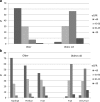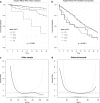Glomerular filtration rate in the elderly and in the oldest old: correlation with frailty and mortality
- PMID: 24664801
- PMCID: PMC4082598
- DOI: 10.1007/s11357-014-9641-4
Glomerular filtration rate in the elderly and in the oldest old: correlation with frailty and mortality
Abstract
The equations for estimating kidney function have become very popular in the last decade. However, the clinical and prognostic meaning of these measures may be very different in older populations. Two cohorts of people aged 65-89 years (older sample) and 90 or more (oldest old sample) were used to investigate the prognostic significance of estimated glomerular filtration rate (eGFR). Additionally, we also investigated whether combining frailty and eGFR may improve the accuracy of frailty in predicting mortality. We found that lower eGFR values were significantly more frequent among frail subjects in both groups. eGFR < 30 was associated with increased risk for all-cause mortality either in subjects aged 65-89 years (HR = 3.71, 95% CI = 1.23-11.2) or in those aged 90 or more (HR = 1.53, 95% CI = 1.05-2.23). In the latter group, a not significant trend for increasing mortality was also observed among people with eGFR > 60 (HR = 1.28, 95% CI = 0.72-2.26). In addition, the oldest old subjects with eGFR > 60 and eGFR < 30 had the lowest hand-grip strength and ADL values. Combining eGFR and frailty status significantly improved the accuracy of frailty in predicting mortality only in the older sample. In conclusion, a U-shaped relationship exists between eGFR and mortality in the oldest old, but not in older individuals. Our findings suggest that eGFR needs to be adjusted for muscle mass/physical performance when estimating kidney function in people aged 90 or more. Nevertheless, in subjects aged 65-89 years, eGFR may improve the accuracy of frailty status in predicting prognosis, thus suggesting that eGFR may represent an additional dimension of frailty syndrome.
Figures
References
-
- Anavekar NS, McMurray JJ, Velazquez EJ, Solomon SD, Kober L, Rouleau JL, White HD, Nordlander R, Maggioni A, Dickstein K, Zelenkofske S, Leimberger JD, Califf RM, Pfeffer MA. Relation between renal dysfunction and cardiovascular outcomes after myocardial infarction. N Engl J Med. 2004;351:1285–1295. doi: 10.1056/NEJMoa041365. - DOI - PubMed
Publication types
MeSH terms
LinkOut - more resources
Full Text Sources
Other Literature Sources
Medical
Research Materials
Miscellaneous


